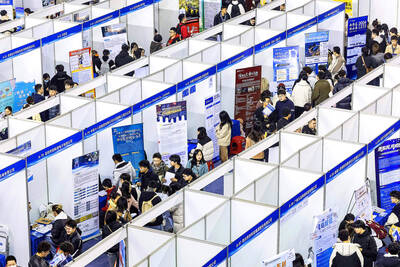The S&P 500 on Friday ended lower, weighed down by Tesla Inc and other technology-related stocks after a solid jobs report torpedoed optimism that the US Federal Reserve might let up its aggressive campaign to reign in decades-high inflation.
Data showed that US employers hired far more workers than expected last month, the 19th straight month of payrolls expansion, with the unemployment rate falling to a pre-COVID-19-pandemic low of 3.5 percent.
The report added to recent data painting an upbeat picture of the world’s largest economy after it contracted in the first half of the year. That deflated investors’ expectations that the Fed might let up in its series of rate hikes aimed at cooling the economy.

Photo: AFP
“This is all about the Fed. A very strong jobs report like we had puts pressure on the Fed to tighten for longer,” 50 Park Investments chief executive Adam Sarhan said. “The market is scared the Fed is going to overshoot again. If they tighten too sharply and too long, that’s going to cause a hard landing, a deep recession.”
Tesla tumbled 6.6 percent and weighed heavily on the S&P 500 and NASDAQ. Facebook-owner Meta Platforms Inc lost 2 percent and Amazon.com Inc fell 1.2 percent, also pulling down the index.
US Treasury yields climbed as odds increased of a 75-basis-point interest rate hike next month. That helped bank stocks, with JPMorgan Chase & Co rising 3 percent, and helping the Dow Jones Industrial Average stay in positive territory.
Focus now shifts to inflation data due this week, with US annual consumer prices expected to rise 8.7 percent for last month after a 9.1 percent rise in June.
Several policymakers last week stuck to an aggressive policy tightening stance until they see strong and long-lasting evidence that inflation was trending toward the Fed’s 2 percent goal.
Surging inflation, the war in Ukraine, Europe’s energy crisis and COVID-19 flare-ups in China have rattled investors this year.
A largely upbeat second-quarter earnings season has helped the S&P 500 bounce back by about 13 percent from its mid-June lows after a rough first-half performance.
The S&P 500 declined 0.16 percent to end the session at 4,145.19 points. The NASDAQ Composite Index declined 0.50 percent to 12,657.55 points, while the Dow Jones Industrial Average rose 0.23 percent to 32,803.47 points.
For the week, the S&P 500 rose 0.36 percent, the Dow fell 0.13 percent and the NASDAQ added 2.15 percent.
Lyft Inc surged almost 17 percent after the ride-hailing firm forecast an adjusted operating profit of US$1 billion for 2024 after posting record quarterly earnings.
Advancing issues outnumbered falling ones within the S&P 500 by a 1.3-to-1 ratio.
The S&P 500 posted four new highs and 30 new lows; the NASDAQ recorded 60 new highs and 38 new lows.
Volume on US exchanges was relatively light, with 10.6 billion shares traded, compared to an average of 10.8 billion shares over the previous 20 sessions.

Stephen Garrett, a 27-year-old graduate student, always thought he would study in China, but first the country’s restrictive COVID-19 policies made it nearly impossible and now he has other concerns. The cost is one deterrent, but Garrett is more worried about restrictions on academic freedom and the personal risk of being stranded in China. He is not alone. Only about 700 American students are studying at Chinese universities, down from a peak of nearly 25,000 a decade ago, while there are nearly 300,000 Chinese students at US schools. Some young Americans are discouraged from investing their time in China by what they see

Taiwan Transport and Storage Corp (TTS, 台灣通運倉儲) yesterday unveiled its first electric tractor unit — manufactured by Volvo Trucks — in a ceremony in Taipei, and said the unit would soon be used to transport cement produced by Taiwan Cement Corp (TCC, 台灣水泥). Both TTS and TCC belong to TCC International Holdings Ltd (台泥國際集團). With the electric tractor unit, the Taipei-based cement firm would become the first in Taiwan to use electric vehicles to transport construction materials. TTS chairman Koo Kung-yi (辜公怡), Volvo Trucks vice president of sales and marketing Johan Selven, TCC president Roman Cheng (程耀輝) and Taikoo Motors Group

MAJOR DROP: CEO Tim Cook, who is visiting Hanoi, pledged the firm was committed to Vietnam after its smartphone shipments declined 9.6% annually in the first quarter Apple Inc yesterday said it would increase spending on suppliers in Vietnam, a key production hub, as CEO Tim Cook arrived in the country for a two-day visit. The iPhone maker announced the news in a statement on its Web site, but gave no details of how much it would spend or where the money would go. Cook is expected to meet programmers, content creators and students during his visit, online newspaper VnExpress reported. The visit comes as US President Joe Biden’s administration seeks to ramp up Vietnam’s role in the global tech supply chain to reduce the US’ dependence on China. Images on

New apartments in Taiwan’s major cities are getting smaller, while old apartments are increasingly occupied by older people, many of whom live alone, government data showed. The phenomenon has to do with sharpening unaffordable property prices and an aging population, property brokers said. Apartments with one bedroom that are two years old or older have gained a noticeable presence in the nation’s six special municipalities as well as Hsinchu county and city in the past five years, Evertrust Rehouse Co (永慶房產集團) found, citing data from the government’s real-price transaction platform. In Taipei, apartments with one bedroom accounted for 19 percent of deals last